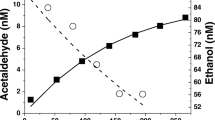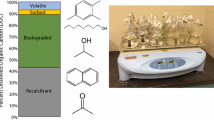Abstract
Acetaldehyde plays an important role in oxidative cycles in the troposphere. Estimates of its air-water flux are important in global models. Biological degradation is believed to be the dominant loss process in water, but there have been few measurements, none in estuaries. Acetaldehyde degradation rates were measured in surface waters at the inflow to the Upper Newport Back Bay estuary in Orange County, Southern California, USA, over a 6-month period including the rainy winter season. Deuterated acetaldehyde was added to filtered and unfiltered water samples incubated in glass syringes, and its loss analyzed by purge and trap gas chromatography mass spectrometry. Filtered samples showed no significant degradation, suggesting that particle-mediated degradation is the dominant removal process. Correlation between measured degradation rate constants in unfiltered incubations and bacteria counts suggests the loss is due to microorganisms. Degradation in unfiltered samples followed first-order kinetics, with rate constants ranging from 0.0006 to 0.025 min-1 (k; average 0.0043 ± 0.006 min-1). Turnover (1/k) ranged from 40 to 1667 min, consistent with prior studies in coastal waters. Acetaldehyde concentrations in the estuary are estimated to range from 30 to ~500 nM (average ~250 nM). Results suggest the estuary is a source of acetaldehyde to the atmosphere.



Similar content being viewed by others
Data and materials availability
The datasets used and/or analyzed during the current study are available from the corresponding author on reasonable request.
References
Beale R, Dixon JL, Arnold SR, Liss PS, Nightingale PD (2013) Methanol, acetaldehyde and acetone in the surface waters of the Atlantic Ocean. J Geophys Res 118:5412–5425
Beale R, Dixon JL, Smyth TJ, Nightingale PD (2015) Annual study of oxygenated volatile organic compounds in UK shelf waters. Mar Chem 171:96–106
Clark CD, Litz LP, Grant SB (2008) Saltmarshes as a source of chromophoric dissolved organic matter to Southern California coastal waters. Limnol Oceanogr 53:1923–1933
Clark CD, de Bruyn WJ, Aiona P (2016) Temporal variation in optical properties of chromophoric dissolved organic matter (CDOM) in Southern California coastal waters with near-shore kelp and seagrass. Limnol Oceanogr 61:32–46
Clark CD, De Bruyn WJ, Brahm B, Aiona P (2020) Optical properties of chromophoric dissolved organic matter (CDOM) and dissolved organic carbon (DOC) levels in constructed water treatment wetlands in Southern California, USA. Chemosphere 247:125906
de Bruyn WJ, Clark CD, Pagel L, Takahara C (2011) Photoproduction of formaldehyde, acetaldehyde and acetone from chromophoric dissolved organic matter in coastal and estuarine waters. J Photochem Photobiol 226:16–22
de Bruyn WJ, Clark CD, Pagel L, Singh H (2013) Loss rates of acetone in filtered and unfiltered coastal seawater. Mar Chem 150:39–44
de Bruyn WJ, Clark CD, Barashy O, Hok S, Sensted M (2017) The biological degradation of acetaldehyde in coastal seawater. Mar Chem 192:13–21
de Bruyn WJ, Clark CD, Senstad M (2020a) Production of acetaldehyde from ethanol in coastal waters. Environ Sci Pollut Res 27:12673–12682
de Bruyn WJ, Clark CD, Senstad M, Tom N, Harrison AW (2020b) Biological Degradation of Ethanol in Southern California Coastal Seawater. Mar Chem 218:103703
Del Vecchio R, Blough N (2004) On the origin of the optical properties of humic substances. Environ Sci Technol 38:14
Dixon JL, Beale R, Nightingale PD (2013) Production of methanol, acetaldehyde, and acetone in the Atlantic Ocean. Geophys Res Lett 40:4700–4705
Gleason MG, Newkirk S, Merrifield MS, Howard J, Cox R, Webb M, Koepcke J, Stranko B, Taylor B, Beck MW, Fuller R, Dye P, Vander SD, Carter J (2011) A conservation assessment of west coast estuaries. https://ir.library.oregonstate.edu/concern/defaults/1r66j546d
Groncharuk VV, Bagri VA, Melnik LA, Chebotareva RD, Bashtan SY (2010) The use of potential in water treatment processes. J Water ChemTechnol 32:1–9
Grosjean D (1991) Ambient levels of formaldehyde, acetaldehyde, and formic acid in southern California: results from a 1-year baseline study. Environ Sci Technol 25:710–715
Grosjean E, Williams EL, Grosjean D (1993) Ambient levels of formaldehyde and acetaldehyde in Atlanta, Georgia. Air Waste 43:469–474
Halsey KH, Giovannoni SJ, Graus M, Zhao Y, Landry Z, Thrash JC, Vergin KL, de Gouw J (2017) Biological cycling of volatile organic carbon by phytoplankton and bacterioplankton. Limnol Oceanogr 62:2650–2661
Kameyama S, Tanimoto H, Inomata S, Tsunogai U, Ooki A, Takeda S, Obata H, Tsuda A, Uematsu M (2010) High-resolution measurement of multiple volatile organic compounds in seawater using equilibrator inlet-proton transfer reaction-mass spectrometry (EI-PTR-MS). Mar Chem 122:59–73
Kieber RJ, Zhou X, Mopper K (1990) Formation of carbonyl compounds from UV-induced photodegradation of humic substances in natural waters: fate of riverine carbon in the sea. Limnol Oceanogr 35:1503–1515
Landfald B, Strom AR (1986) Choline-glycine Betaine pathway confers a high level of osmotic tolerance in Escherichia coli. J Bacteriol 165:849–855
Lewis AC, Hopkins JR, Carpenter LJ, Stanton J, Read KA, Pilling MJ (2005) Sources and sinks of acetone, methanol, and acetaldehyde in North Atlantic marine air. Atmos Chem Phys 5 (7):1963–1974
Lidbury I, Kimberley G, Scanian DJ, Murrell JC, Chen Y (2015) Comparative genomics and mutagenesis analysis of choline metabolism in marine Roseobacter clade. Environ Microbiol 17:5048–5062
Millet DB, Jacob DJ, Custer TG, de Gouw JA, Goldstein AH, Karl T, Singh HB, Sive BC, Talbot RW, Warneke C, Williams J (2008) New constraints on terrestrial and oceanic sources of atmospheric methanol. Atmos Chem Phys 8:6887–6905
Millet DB, Guenther A, Siegel DA, Nelson NB, Singh HB, de Gouw JA, Warneke C, Williams J, Erdekens G, Sinha V, Karl T, Flocke F, Apel E, Riemer DD, Palmer PI, Barkley M (2010) Global atmospheric budget of acetaldehyde: 3-D model analysis and constraints from in situ and satellite observations. Atmos Chem Phys 10:3405–3425
Mopper K, Stahovec WL (1986) Sources and sinks of low molecular weight organic carbonyl compounds in seawater. Mar Chem 19:305–321. https://doi.org/10.1016/0304-4203(86)90052-6
Moran MA, Hodson RE (1994) Dissolved humic substances of vascular plant origin in a coastal marine environment. Limnol Oceanogr 39(4):762–771
Naik V, Fiore AM, Horowitz LW, Singh HB, Wiedinmeyer C, Guenther A, de Gouw JA, Millet DB, Goldan PD, Kuster WC, Goldstein A (2010) Observational constraints on the global atmospheric budget of ethanol. Atmos Chem Phys Discuss 10:925–945
Read KA, Carpenter LJ, Arnold SR, Beale R, Nightinggale PD, Hopkins JR, Lewis AC, Lee JD, Mendes L, Pickering SJ (2012) Multiannual observations of acetone, methanol, and acetaldehyde in remote tropical Atlantic air: implications for atmospheric OVOC budgets and oxidative capacity. Environ Sci Technol 46:11028–11039
Schlundt C, Tegtmeier S, Lennartz S, Bracher A, Marandino CA (2017) Oxygenated volatile organic carbon in the western Pacific convective centre: ocean cycling, air-sea gas exchange and atmospheric transport. Atmos Chem Phys 17:10837–10854
Singh H, Chen Y, Staudt A, Jacob D, Blake D, Heikes B, Snow J (2001) Evidence from the Pacific troposphere for large global sources of oxygenated organic compounds. Nature 410:1078–1081
Singh HB, Slas LJ, Chatfield RB, Czech E, Fried A, Walega J, Evans MJ, Field BD, Jacob DJ, Blake D, Heikes B, Talbot R, Sachse G, Crawford JH, Avery MA, Sandholm S, Fuelberg H (2004) Analysis of atmospheric distribution sources and sinks of oxygenated volatile organic chemicals based on measurements over the Pacific during TRACE-P. J Geophys Res 109:D15S07. https://doi.org/10.1029/2003JD003883
Sinha V, Williams J, Meyerhöfer M, Riebesell U, Paulino AI, Larsen A (2007) Air-sea fluxes of methanol, acetone, acetaldehyde, isoprene and DMS from a Norwegian fjord following a phytoplankton bloom in a mesocosm experiment. Atmos Chem Phys 7(3):739–755
Sinha V, Williams J, Riebesell U, Paulino AI, Larsen A (2006) Air sea fluxes of methanol, acetone, acetaldehyde, isoprene and DMS from a Norwegian fjord following a phytoplankton bloom in a mesocosm experiment. Atmos Chem Phys Discuss 6:9907–9935
Strecker E, Mangarella P, Brandt N, Hesse T, Muneepeerakul R, Rathfelder K, Leisenring M (2004) The Natural Treatment System Master Plan to Meet Pollutant Loading Limits. Case Study of San Diego Creek, Orange County. https://doi.org/10.1061/40644(2002)169
Tobias C, Neubauer S (2019) Salt marsh biogeochemistry—an overview. Ch 16, Coastal Wetlands, 2nd ed. Elsevier
Wang S, Hornbrook RH, Hills A, Emmons LK, Tilmes S, Lamarque J-F, Jiminez JL, Campuzano-Jost P, Nault BA, Crounse JD, Wennberg PO, Kim M, Allen H, Ryerson TB, Thompson CR, Peischi J, Moore F, Nance D, Hall B, Elkins J, Tanner D, Huey LG, Hall SR, Ullmann K, Orlando JJ, Tyndall GS, Flocke FM, Ray E, Hanisco TF, Wolfe GM, St. Clair J, Commane R, Daube B, Barletta B, Blake DR, Weinzieri B, Dollner M, Conley A, Vitt F, Wofsy SC, Riemer DD, Apel EC (2019) Atmospheric acetaldehyde: importance of air-sea exchange and a missing source in the remote troposphere. Geophys Res Lett 46:5601–5613
Yang M, Beale R, Liss P, Johnson M, Blomquist B, Nightingale P (2014) Air-sea fluxes of oxygenated volatile organic compounds across the Atlantic Ocean. Atmos Chem Phys 14:7499–7517
Zhou X, Mopper K (1993) Carbonyl compounds in the lower marine troposphere over the Caribbean Sea and Bahamas. J Geophys Res Oceans 98(C2):2385–2392
Zhou X, Mopper K (1997) Photochemical production of low molecular weight carbonyl compounds in seawater and surface microlayer and their air sea exchange. Mar Chem 56:201–213
Zhu Y, Kieber DJ (2019) Concentrations and photochemistry of acetaldehyde, glyoxal and methylglyoxal in the northwest Atlantic Ocean. Environ Sci Technol 53:9512–9521
Acknowledgments
The authors thank the National Science Foundation (OCE # 1233091; CHE #1337396) for funding this work. AWH is supported by a fellowship from the Grand Challenges Initiative at Chapman University. The authors thank Anthony Castagnola and Brandon Lamb for assistance with sampling and measurements.
Funding
This work is supported by the National Science Foundation (OCE # 1233091; CHE #1337396). Funds from this funding body provided materials and supplies for the measurements and salary support for students who worked on this project.
Author information
Authors and Affiliations
Contributions
MS and SH collected samples and made the measurements. AWH performed data analysis and contributed to the writing of the manuscript. WDB and CDC obtained funding to support the work, supervised the project, analyzed data and wrote the manuscript. All authors read and approved the final manuscript.
Corresponding author
Ethics declarations
Competing interests
The authors declare no competing interests
Additional information
Responsible Editor: Ester Heath
Publisher’s note
Springer Nature remains neutral with regard to jurisdictional claims in published maps and institutional affiliations.
Rights and permissions
About this article
Cite this article
de Bruyn, W.J., Clark, C.D., Harrison, A.W. et al. The degradation of acetaldehyde in estuary waters in Southern California, USA. Environ Sci Pollut Res 28, 35811–35821 (2021). https://doi.org/10.1007/s11356-021-13232-x
Received:
Accepted:
Published:
Issue Date:
DOI: https://doi.org/10.1007/s11356-021-13232-x




